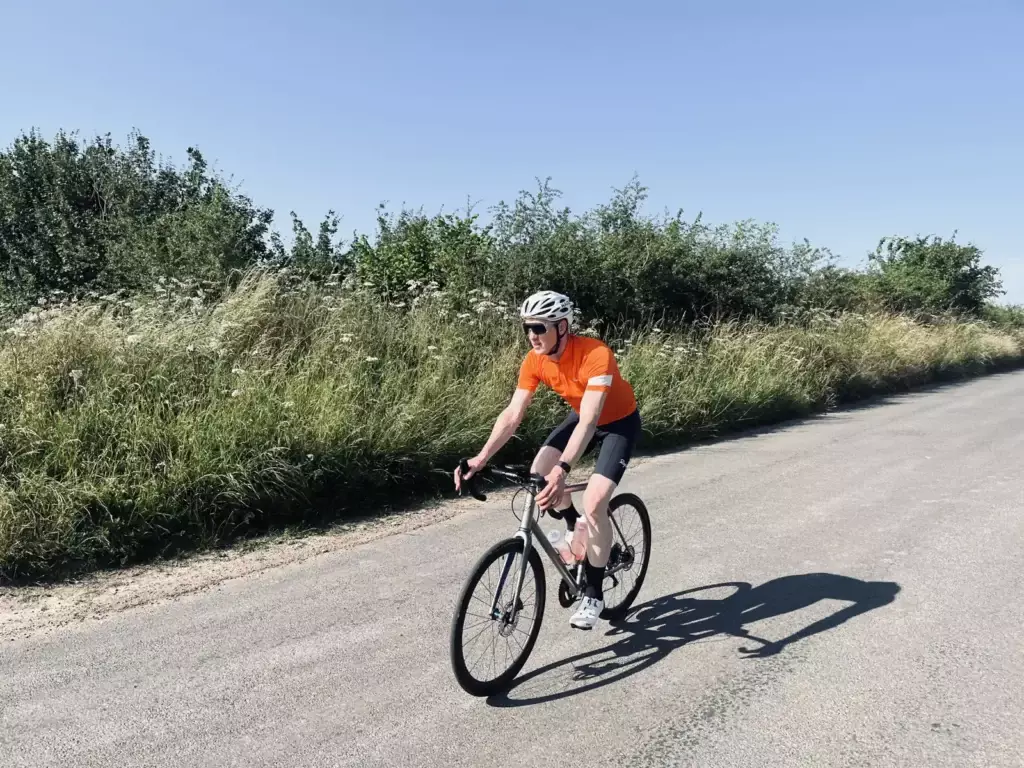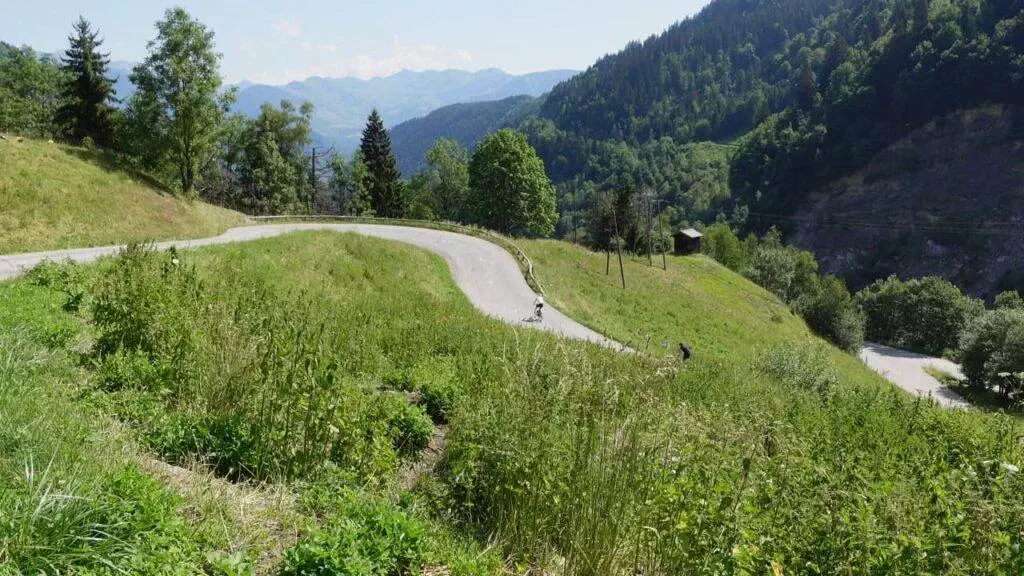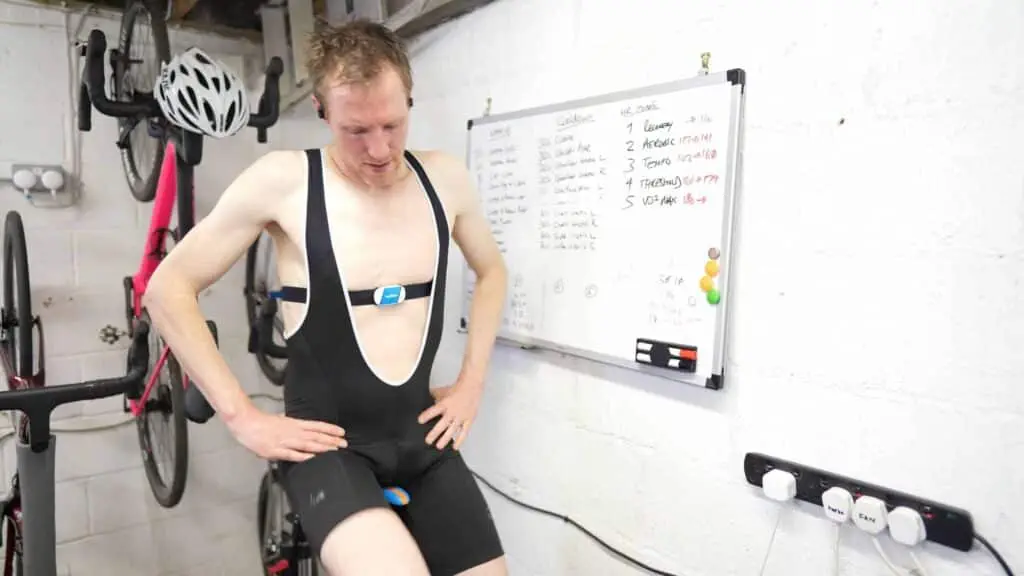If you’re eager to boost your cycling skills and hop on the saddle with confidence, you’re in the right place!
While having personal coaching can certainly be beneficial, training plans can help you on your cycling journey.
In this blog post, we provide you with a results-driven 4-week cycling plan with training tips that will take your cycling prowess to new heights.
Key Takeaways: 4-Week Cycling Training Plan
- Week 1 is focused on building your endurance base.
- Week 2 is about stepping up the intensity.
- Week 3 incorporates strength training into your cycling training plan.
- Week 4 is focused on reducing training volume.

Before We Begin
A few basic concepts to keep in mind as you work through the plan:
Certainly! Here are some key concepts to keep in mind as readers work through a 4-Week Cycling Training Plan:
- Mantra: Easy sessions are easy; Hard sessions are hard: Stick to the plan’s intensity guidelines. Easy rides should be truly easy to allow for recovery, while hard sessions should challenge you to push your limits.
- Listen to your body: Pay attention to signs of fatigue, soreness, or potential injury. Rest is crucial for recovery and improvement, so don’t hesitate to take an extra rest day if needed.
- Appreciate where you are starting from, and where you are going: Be realistic about your current fitness level and set achievable goals. Celebrate small milestones along the way to stay motivated.
- Off-bike strength training is key to achieving on-bike performance improvements: Incorporate strength training exercises such as squats, lunges, and core workouts to build muscle strength and stability, which will enhance your cycling performance.
- Consistency is crucial: Stick to the training plan as closely as possible. Consistent effort over the four weeks will yield the best results.
- Nutrition and hydration: Fuel your body with a balanced diet rich in carbohydrates, proteins, and fats. Stay hydrated before, during, and after rides to maintain peak performance.
- Proper bike fit and gear: Ensure your bike is properly fitted to avoid discomfort and potential injury. Wear appropriate cycling gear, including a helmet, to enhance safety and comfort.
- Warm-up and cool-down: Always start with a warm-up to prepare your muscles and end with a cool-down to aid recovery and prevent injury.
- Mental focus: Stay mentally engaged during your rides. Visualization and positive self-talk can help you push through tough sessions and stay motivated.
- Track your progress: Keep a training log to monitor your improvements and adjust the plan as needed based on your performance and how you feel.
These concepts will help you navigate training plans effectively, ensuring you make the most of your efforts and achieve your cycling goals.
Week 1: Building Endurance
Begin by building your endurance by increasing the duration of your rides at a moderate intensity.
Day 1
1-hour ride with 5 sets of 5 x 15-second fast pedaling intervals
- Maintain a high cadence during the intervals.
- Push yourself during each 15-second effort.
Day 2
- 30 minutes in the active recovery zone
- Keep the intensity low.
Day 3
- 1 hour with 3 x 10-minute big gear tempo intervals at 50rpm to 70rpm
- Shift into a bigger gear and maintain a steady tempo effort.
- Aim for a cadence of 50-70rpm.
Day 4
- Either 30 minutes in the active recovery zone or a full rest day.
Day 5
- 2 to 3 hours in the Endurance zone
- Ride at a steady pace that challenges your aerobic fitness.
Day 6
- 1 hour in the active recovery zone
- Engage in easy spinning and low intensity.
Day 7
- Full rest day

Week 2: Increasing Intensity
Get ready to elevate your performance with these challenging workouts:
Day 1
- 1.5 hours with 4 sets of 5 x 30-second fast pedaling intervals
- Increase the intensity with longer intervals.
- Maintain a high cadence and strong effort during each 30-second interval.
Day 2
- 1 hour in the active recovery zone
- Light spinning to promote blood flow and recovery.
Day 3
- 1.5 hours with 5 x 15-second big gear high-quality sprints at 60rpm to 80rpm
- Through the middle section of the ride do 5 x 12-15 second high-quality sprints with 5+ minutes breaks between efforts.
Day 4
- Either 30 minutes in the active recovery zone or a full rest day.
Day 5
- 1 hour of hill climbs every 5 minutes
- Perform 6 hill climbs with a with high cadence of 95rpm and rest for 5 minutes with light pedaling.
Day 6
- 1.5 hours with 4 sets of 5 x 30-second fast pedaling intervals
Day 7
- Full rest day

Week 3: Endurance and Strength
Week 3 incorporates strength training and an increased training load into your cycling training plan.
Day 1
- 1 hour with 3 sets of 5 x 1-minute pedaling intervals at a high cadence of 95rpm to 110rpm
- Helps improve leg speed and neuromuscular coordination – be cautious of your upper body and posture.
Day 2
- 30 mins to 1 hour of strength training
- Target major muscle groups with squats, lunges, deadlifts, and core exercises.
Day 3
- Rest day
Day 4
- 1.5 to 2 hours of hill climbs
- Helps to challenge your muscles and cardiovascular system.
Day 5
- 1 hour in the active recovery zone
- Ride at a moderate, easy pace.
Day 6
- 2 to 3 hours of riding in the Endurance zone & 30 mins to 1 hour of strength training
- Do the cycling training first.
Day 7
- Full rest day

Week 4: Tapering Down
To reach your optimal performance level and peak as a cyclist, it’s essential to implement a tapering phase to minimize fatigue and sustain training intensity.
Day 1
- 45 minutes of easy pedaling with 3 sets of 5 x 30-minute fast pedaling
- Easy pace with a few short bursts of higher-intensity ride intervals.
Day 2
- 1 hour in the active recovery zone, keeping the effort level low
Day 3
- Training day with 30 minutes of easy pedaling or cross-training activity
Day 4
- Full rest day or very light activity
Day 5
- 1 to 1.5 hours of riding in the endurance zone
- Keep your feet flat and posture stable.
Day 6
- 45 minutes in the activity recovery zone with a final push
- 42 minutes of gentle spinning and go all out on low gear for the last 3 minutes.
Day 7
- Full rest day
Cycling Training Plan Conclusion
You’ve successfully completed four weeks of cycling training! Now it’s time to rest before the big event. If you are looking to push on further with training, check out this article on training for a century ride.
Nutrition
To fuel your rides and optimize your cycling performance, it’s important to pay attention to what you eat before, during, and after rides.
Here’s a breakdown of the essential nutrients and strategies of cycling nutrition:
- Carbohydrates are your best friend when it comes to cycling. They’re stored in your muscles as glycogen and serve as the body’s primary energy source.
- Fats allow you to improve your glycogen stores and use fat for fuel. Foods rich in Omega-3 and Omega-6 fatty acids are excellent sources.
- Protein is key for tissue repair and muscle building. Eat a protein-rich meal at least 90 minutes before and again 30 minutes after a ride.
- On-the-bike nutrition includes energy gels, bars, chews, and bananas for quick and easily digestible supplements. For a quick on-bike snack bar the CLIF Bar mini is a favourite of mine.
- Hydration: Keep drinking and stay hydrated, ideally using an electrolyte tablet. Something like Nuun tabs are effective for replenishing electrolytes lost through sweat and maintaining proper hydration levels.
Next Step: Tracking Progress
Keeping tabs on your progress is part of any cycling training plan. It helps you see how far you’ve come and guides you in making adjustments to your training.
Track your cycling progress like this:
- Simple time trial with a stopwatch: Find a road or trail where you can push yourself to the max and record your time.
- Rate of perceived exertion (RPE): Exertion levels are graded on a scale from 1 to 10. At 1, you’re in a state of rest, while at 7 or 8, you’re really digging deep. A full-blown 10 is an all-out, mind-boggling effort.
As your fitness improves, the same level of effort feels easier. This indicates progress and can help gauge your fatigue levels and overall training status. - Monitor your heart rate: Heart rate training is a widely-used method. You’ll need a heart rate monitor and a compatible device.The heart rate monitor measures the beats per minute (BPM). The Wahoo TICKR is my go-to HRM, but there are others like Polar that work great also.
Based on these readings, you can structure your training by riding intervals at specific heart rate zones. - Power meter: A power meter cuts through the noise and gives you precise data on the actual force you’re exerting. Of all the power meters I’ve tried, the Favero Assioma Duo pedals are by far my favourite ones for simplicity.

